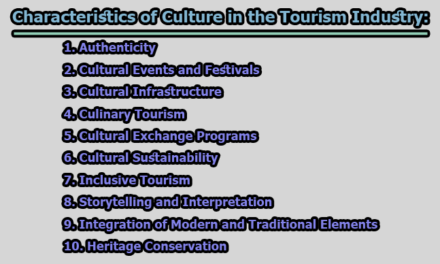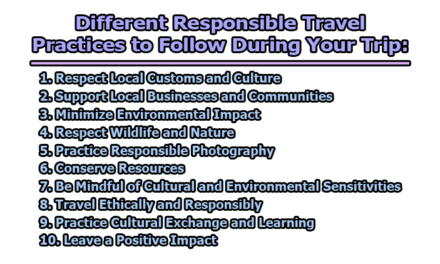Role of Tourism Organizations in Destination Management:
Tourism is a significant industry that contributes to the global economy. Destination management is a process that involves planning, coordinating, and managing various aspects of tourism in a particular destination. Tourism organizations play a vital role in destination management. These organizations are responsible for promoting and marketing the destination to attract visitors and provide them with a quality experience. In this article, we will discuss the role of tourism organizations in destination management.
- Leadership: Tourism organizations provide leadership in destination management by coordinating the efforts of various stakeholders, including government agencies, businesses, community groups, and residents. They facilitate communication and collaboration among these groups to ensure that everyone is working towards a common goal.
- Strategic Planning: Tourism organizations develop and implement strategic plans for destination development and management. They identify the strengths, weaknesses, opportunities, and threats of a destination and develop strategies to address them. They also set goals, objectives, and performance indicators to measure the success of the destination.
- Destination promotion: Tourism organizations promote the destination to potential tourists through various media channels such as television, print, and digital media. For instance, Tourism Australia promotes the country’s attractions such as the Great Barrier Reef, Uluru, and the Sydney Opera House through various campaigns.
- Marketing strategies: Tourism organizations create and implement marketing strategies that focus on attracting tourists to the destination. These strategies may include social media campaigns, influencer marketing, and search engine optimization.
- Product development: Tourism organizations work with local businesses and stakeholders to develop and improve tourism products and services. For instance, Tourism New Zealand works with tour operators and accommodation providers to develop new products that cater to the changing needs of tourists.
- Infrastructure Development: Tourism organizations work with government agencies and private sector partners to develop and maintain tourism infrastructure, including transportation, accommodation, and attractions. They identify infrastructure needs and prioritize investment to improve the visitor experience.
- Research and analysis: Tourism organizations conduct research and analysis to understand market trends, consumer behavior, and competition. This helps them develop effective marketing strategies and product offerings.
- Sustainable tourism: Tourism organizations promote sustainable tourism practices to ensure the long-term viability of the destination. For instance, the Global Sustainable Tourism Council works with destinations to develop sustainable tourism practices.
- Environmental Management: Tourism organizations promote sustainable tourism practices to preserve the environment and minimize negative impacts. They encourage businesses to adopt eco-friendly practices and educate visitors about responsible tourism behavior.
- Cultural Heritage Preservation: Tourism organizations work with local communities to preserve the cultural heritage of the destination. They promote cultural tourism experiences that celebrate local traditions and customs and provide economic benefits to the community.
- Standards and Accreditation: Tourism organizations establish and enforce standards and accreditation programs for tourism businesses to ensure quality and consistency in the visitor experience. They also provide certification and accreditation for tourism professionals to enhance their credibility and professionalism.
- Community Engagement: Tourism organizations engage with local communities to ensure that they benefit from tourism development. They consult with community members to understand their needs and concerns and involve them in decision-making processes.
- Capacity Building: Tourism organizations provide training and capacity-building programs to local businesses and communities to improve their skills and knowledge in tourism management and marketing.
- Destination branding: Tourism organizations create and promote a unique brand for the destination. This helps to differentiate the destination from its competitors and attract tourists who are looking for a specific type of experience.
- Partnerships: Tourism organizations work with local businesses, government agencies, and other stakeholders to promote and develop the destination. For instance, VisitScotland works with local businesses and communities to promote tourism in Scotland.
- Crisis management: Tourism organizations play a critical role in managing crises that may impact the destination’s tourism industry. For instance, after the Christchurch earthquake in New Zealand, Tourism New Zealand worked with stakeholders to promote the destination and assure tourists that it was safe to visit.
- Visitor information: Tourism organizations provide visitors with information about the destination, including maps, brochures, and guides. For instance, VisitBritain provides visitors with information about attractions, events, and accommodations in the UK.
- Data Management: Tourism organizations collect, analyze, and manage data on visitor trends, market demand, and destination performance. They use data to inform decision-making, evaluate the effectiveness of marketing campaigns and tourism products, and identify areas for improvement.
- Quality assurance: Tourism organizations work with local businesses to ensure that they meet quality standards. This helps to ensure that tourists have a quality experience and are more likely to return to the destination.
- Training and development: Tourism organizations provide training and development programs for local businesses and employees. This helps to improve the quality of tourism products and services and ensures that employees have the necessary skills to provide a quality experience to tourists.
- Market segmentation: Tourism organizations segment the market to identify specific groups of tourists and develop marketing strategies that target these groups. For instance, VisitCalifornia targets families, outdoor enthusiasts, and luxury travelers with different marketing campaigns.
- Events management: Tourism organizations organize and promote events that attract tourists to the destination. For instance, the Edinburgh Festival Fringe in Scotland attracts thousands of visitors each year.
- Destination assessment: Tourism organizations conduct assessments of the destination’s tourism infrastructure and make recommendations for improvement. This helps to ensure that the destination is competitive and attractive to tourists.
- Tourism policy development: Tourism organizations work with government agencies to develop tourism policies that support the growth of the industry. For instance, the Australian Tourism Industry Council works with the Australian government to develop policies that support the growth of tourism in the country.
- Visitor satisfaction: Tourism organizations collect feedback from visitors to assess their level of satisfaction with the destination. This helps to identify areas for improvement and ensure that tourists have a positive experience.
- Destination management planning: Tourism organizations work with local stakeholders to develop and implement a comprehensive destination management plan that outlines the goals, strategies, and actions needed to ensure the sustainable growth of the tourism industry.
- Digital marketing: Tourism organizations use digital marketing strategies to promote the destination to potential tourists. This includes social media marketing, search engine optimization, and online advertising.
- Destination image management: Tourism organizations manage the destination’s image through various media channels. This includes managing online reviews and reputation, responding to negative feedback, and promoting positive aspects of the destination.
- Stakeholder engagement: Tourism organizations engage with local stakeholders, including businesses, residents, and community groups, to ensure that the tourism industry benefits the local community and is sustainable over the long term.
- Revenue Generation: Tourism organizations generate revenue for the destination through various means, including visitor spending, taxes, and fees. They work to maximize the economic benefits of tourism while minimizing the negative impacts on the local community and the environment.
- Destination Monitoring: Tourism organizations monitor the performance of the destination to evaluate the effectiveness of destination management strategies and identify areas for improvement. They use performance indicators to measure the success of the destination and adjust strategies accordingly.
- Tourism Industry Development: Tourism organizations work to develop and strengthen the tourism industry in the destination. They provide support and resources to tourism businesses, promote entrepreneurship and innovation in the industry, and collaborate with educational institutions to provide training and education for tourism professionals.
In conclusion, tourism organizations play a critical role in destination management by providing leadership, strategic planning, marketing, and operational support. They work with various stakeholders to create a destination that is attractive to tourists, generates income for the local community, and preserves the environment and culture. The success of destination management depends on the effective collaboration and coordination of all stakeholders, and tourism organizations play a vital role in facilitating this collaboration.
References:
- Hall, C.M. and Page, S.J. (2019) The Routledge Handbook of Tourism in Asia. Routledge.
- Buhalis, D. and Costa, C. (2012) Tourism Business Frontiers: Consumers, Products, and Industry. Routledge.
- Prideaux, B. (2019) Tourism Research Methods: Integrating Theory with Practice. CABI.
- UNWTO (2021) Tourism and the Sustainable Development Goals – Journey to 2030. UNWTO.
- Buckley, R. and Zhong, L. (2019) Tourism and Poverty Reduction: Pathways to Prosperity. Channel View Publications.
- Sharpley, R. and Telfer, D.J. (2015) Tourism and Development: Concepts and Issues. Channel View Publications.
- Page, S.J. and Connell, J. (2019) Tourism: A Modern Synthesis. Cengage Learning.
- Andriotis, K. (2015) Cultural tourism and the challenges of sustainability. Journal of Tourism and Cultural Change, 13(1), pp.1-5.
- Gursoy, D. and Rutherford, D.G. (2004) Host attitudes toward tourism: An improved structural model. Annals of Tourism Research, 31(3), pp.495-516.
- Gursoy, D. and Rutherford, D.G. (2004) Host attitudes toward tourism: An improved structural model. Annals of Tourism Research, 31(3), pp.495-516.

Library Lecturer at Nurul Amin Degree College










